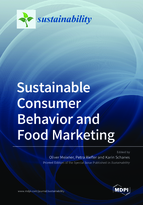Sustainable Consumer Behavior and Food Marketing
A special issue of Sustainability (ISSN 2071-1050). This special issue belongs to the section "Sustainable Food".
Deadline for manuscript submissions: closed (30 June 2021) | Viewed by 80929
Special Issue Editors
Interests: consumer behavior; food supply chain; decision making in the agri-food sector; corporate social responsibility; innovation management; sustainable food consumption
Interests: consumer behavior; consumer motifs for regional food consumption; consumer perspectives on corporate social responsibility; concepts of sustainable consumer behavior; concepts of consumption reduction/sufficiency
Special Issue Information
Dear Colleagues,
It is a pleasure to invite you to submit original research contributions in the field of sustainable food marketing and consumer behavior. Sustainability is a topic of increasing importance, in particular across all stages along the food supply chain. In order to facilitate sustainability in the supply chain, target 12 of the global Sustainable Development Goals (SDGs) is especially dedicated to sustainable consumption and production.
Food companies will need to effectively incorporate social responsibility into their business actions. There is a consensus that also individuals need to alter their current consumption patterns to achieve a more sustainable way of living and to reduce impacts on the environment and society.
Beyond individual changes in consumer behavior and along the supply chain, there has been an increasing interest in community-based initiatives and movements (e.g., alternative food networks, community gardens, food sharing). Groupings of people collectively strive to develop practical alternatives that often add to and/or replace existing processes and structures which are incompatible with their visions of a sustainable society.
In times of growing challenges such as climate change, increasing world population and food demand, shortages of arable land, and urbanization, sustainable consumer behavior is of significant importance to achieve the SDGs and climate goals. For this Special Issue, we welcome original submissions that are linked to the following subject areas:
- Marketing for green food products
- Consumer decision-making for sustainable food and beverages
- Communication of sustainability within the food supply chain
- Organic, seasonal, and regional food consumption
- Corporate social responsibility in the food supply chain
- Community-based initiatives and movements in the food sector (e.g., food sharing, alternative food networks, community gardens)
- Carbon-friendly consumer behavior within the food domain (e.g., reduction of meat consumption and food waste, sufficiency)
- Cross-national aspect of sustainable marketing in the food sector
Assoc. Prof. Oliver Meixner
Prof. Dr. Petra Riefler
Dr. Karin Schanes
Guest Editors
References:
- Bangsa, A.B., & Schlegelmilch, B.B. (2019). Linking sustainable product attributes and consumer decision-making: Insights from a systematic review. Journal of Cleaner Production (in press). https://doi.org/10.1016/j.jclepro.2019.118902
- Lunde, M.B. (2018). Sustainability in marketing: a systematic review unifying 20 years of theoretical and substantive contributions (1997–2016) AMS Rev 8 (3-4), 85-110. https://doi.org/10.1007/s13162-018-0124-0
- O’Keefe, L., McLachlan, C., Gough, C., Mander, S., & Bows-Larkin, A. (2016). Consumer responses to a future UK food system. British Food Journal 118 (2), 412-428. https://doi.org/10.1108/BFJ-01-2015-0047
- Olson, E.L. (2013). It’s not easy being green: the effects of attribute tradeoffs on green product preference and choice J. of the Acad. Mark. Sci. 41, 171-184. https://doi.org/10.1007/s11747-012-0305-6
Manuscript Submission Information
Manuscripts should be submitted online at www.mdpi.com by registering and logging in to this website. Once you are registered, click here to go to the submission form. Manuscripts can be submitted until the deadline. All submissions that pass pre-check are peer-reviewed. Accepted papers will be published continuously in the journal (as soon as accepted) and will be listed together on the special issue website. Research articles, review articles as well as short communications are invited. For planned papers, a title and short abstract (about 100 words) can be sent to the Editorial Office for announcement on this website.
Submitted manuscripts should not have been published previously, nor be under consideration for publication elsewhere (except conference proceedings papers). All manuscripts are thoroughly refereed through a single-blind peer-review process. A guide for authors and other relevant information for submission of manuscripts is available on the Instructions for Authors page. Sustainability is an international peer-reviewed open access semimonthly journal published by MDPI.
Please visit the Instructions for Authors page before submitting a manuscript. The Article Processing Charge (APC) for publication in this open access journal is 2400 CHF (Swiss Francs). Submitted papers should be well formatted and use good English. Authors may use MDPI's English editing service prior to publication or during author revisions.
Keywords
- consumer behavior
- green products
- climate change
- sustainable food
- community-based initiatives
- sufficiency
- food waste reduction
- corporate social responsibility







